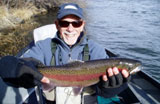Description
Why feature something in the Leader as basic
as a Wooly Bugger? A reasonable question,
for sure. Every beginner fly tying class
opens with a WB—and for good reason. It’s
simple to tie, materials are cheap and
commonly available, and, of all things, it
really does work. But, having said that, I
need to add that there are WBs, and…well,
there are WBs. In other words, it may not be
so simple—i.e. there are some subtle
characteristics of a properly tied WB and
some tricky techniques you need to know in
order to bring out those characteristics and
maximize the effectiveness of the bug. It’s
worth the time to enumerate some of these
characteristics and techniques before
getting into specifics of materials and
tying steps.
1. The hook. It is my view that a
straight-eye, bent shank hook will
create the best profile and enhance
hooking fish. I prefer the Daichii 1260
because it is 2X long, has a nice, wide
gape, a straight eye, and a nicely
shaped shank that suggests life, as
opposed to sterile straight-shank hooks.
2. Sparseness. Over the years I’ve
harped on sparseness of materials
applied to the hook. There are, of
course, some exceptions such as bass
hair bugs which demand as much material
as can be jammed onto a hook. Most
natural critters are slender and
sleek—so why gob on the material?
Store-bought WBs are way over-dressed: a
big blob of marabou for the tail, too
large chenille for the body, and hackle
fit for a size 3/0 hook. Keep it
slender: use a small amount of marabou
for the tail; small- or medium-size
chenille; and small, appropriately sized
hackle.
3. Winding the hackle. Most
non-dry-fly hackle is tapered—smaller at
the tip than at the butt of the feather.
We need to take advantage of this
characteristic in order to achieve a
good profile. Here’s the question:
should the hackle be tied in by its tip,
or by the quill at its butt? The latter
method would produce an unnatural and
incorrect profile, in my view—wider at
the tail end of the fly than at the
head. So, it’s best to tie the feather
in by its tip. There is another issue
here: How many hackle wraps are best?
Stillwater guru Denny Rickards urges
tyers to limit the wraps to 4 or 5
because if the wraps are too close to
each other they will inhibit motion in
the current or on the retrieve.
4. The “brushed back” look—meaning
that the hackle, when palmered up the
shank, should appear to be swept
rearward when wrapped through the body.
If done properly, this will enhance the
fly’s motion. There is a way to force
the hackle to sweep rearward: As you
wrap forward, twist your hackle pliers
clockwise at the end of each wrap. This
will usually work on even the most
resistant hackles.
5.
To bead or not to bead…? The jury
is out on this one. Some tyers like a
bead at the head to aid in sinking the
fly; others vehemently insist that the
bead inhibits fly motion in the water
and looks unnatural. Personally, I
always carry some of each and avoid
debating the topic.
OK, let’s go ahead and tie one using these
ideas.
Tying Instructions
|
1.
De-barb the hook and place it in
the vise. If you are going to use a
bead, put it on the hook now. If you are
going to weight the fly, place the
weight on the hook now. Tie the thread
onto the hook and run it back to the
back of the barb.
2.
Tie in a small bunch of black
marabou. Select the type of plume that
has long, wavy barbules. The marabou
tail should be about 1.5x shank length.
|
 |
|
|
|
3.
Tie in a black saddle hackle by
its tip, above the back of the barb. At
the same point, tie in a nice, long
saddle hackle with barbs equal to about
1.5x the hook gape in length, and a
piece of black sparkle chenille after
skinning about ¼” of the chenille off
the core.
|

|
|
|
|
4.
Wrap the chenille forward in
tight turns, being careful to not
overlap the previous turn.
|
 |
|
|
|
5.
Grab the hackle with your hackle
pliers and wrap it forward through the
chenille. Four or five wraps is
sufficient. Use suggestion number 4 at
the top of the article to give the
hackle a “swept back” appearance. Tie
off the hackle at least one eye’s length
behind the eye (or directly behind the
bead if you are using one), and wrap a
small, neat head. Whip finish and apply
a drop of super glue.
|
 |
|
|
Fish this bug on the end of a
long leader with an intermediate
line, using a slow retrieve.
 |
|

